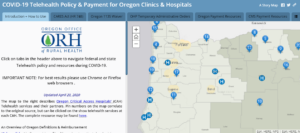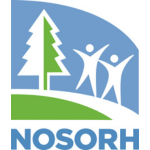by Beth Blevins
The Oregon Office of Rural Health (OORH) has created a new repository that houses state and federal telehealth policy and payment resources in response to rapidly evolving changes during the COVID-19 pandemic.

Homepage of the StoryMap
COVID-19 Telehealth Policy and Payment for Oregon Clinics and Hospitals uses ArcGIS StoryMaps, an interactive platform with sections on the CARES Act, the Oregon Disaster Relief Waiver, state and federal payment resources, and pertinent webinars and events. It went live on April 3, 2020.
“When COVID-19 started, there was a rapid fire of policy changes coming out,” said Rose Locklear, OORH Field Services Program Manager. “I wanted to create a resource to organize all the information in a way that made sense to me. And I realized that just putting them up on our website as links wasn’t going to be useful—if I couldn’t quickly find what I was looking for others would probably experience the same thing.”
Locklear said she also realized that the situation was constantly evolving, meaning that something published at the beginning of March would no longer be relevant a couple of weeks later. “So I wanted to put these resources in something that was easy to navigate and update on my end without having to go through our IT, because by the time they might update it I would need to make another change,” she said.
Locklear chose the ArcGIS StoryMaps platform because it offered her “something to throw everything into,” she said. “The story map allows you to import text, images, hyperlink to sources, and embed multimedia content. On the left side you can import text and on the right side you can put in maps, web pages, or videos. It’s not perfect, but works well to organize and house quality information, and it’s free.” (The public account of the ArcGIS platform, which she used for the story map, is free for personal, noncommercial use.)
“I’m not a data person—my background is in public health,” Locklear said, “but I enjoy visualizing data and making it easy for people to understand. In public health, in general, that’s often a challenge. We’ve got so much information—how do we organize it and display it so people can easily find it?”
Another challenge was that the CARES Act has increased the number of healthcare facilities that can provide telehealth services during the pandemic. “You’ve now got folks who never did telehealth before, who need to understand the basics about payment rules and regulations because these differ by payer,” Locklear said. “So, I had to create something that incorporated all these pieces.”
The intended audience is anyone who wants a crash course in telehealth policy or any Oregon providers impacted by the state and federal policy changes. Other State Offices of Rural Health (SORHs) are welcome to use and adapt this story map.
“There are a lot of inventive things a state could do to make it their own,” Locklear said. “There’s definitely a learning curve if you’ve never worked with ArcGIS StoryMaps. However, replicating one like this without geographical data is much easier. There are tutorials online that offer help, and I would be more than happy to answer any questions from anyone who might be interested in the project.”
The telehealth policy and payment resource is a component of ORH COVID-19 Resources for Rural Health. Other sections on that site include information on EMS, Critical Access Hospitals, Grants, Policy, and Rural Health Clinics.
After the pandemic subsides, OORH will keep using the story map as a repository for telehealth policy and information.
—————-
Other SORH COVID-19 Resources
The South Carolina Office of Rural Health (SCORH) created its Coronavirus Resources for Rural Communities and Providers website in the early days of the state’s pandemic response to provide a clearinghouse of critical information specific to rural healthcare providers, said Bridget Winston, SCORH Director of Communications.
“We wanted to cut through the overwhelming quantity of information being disseminated, and just share what our providers needed to be able to serve their rural patients—guidance on testing, PPE, billing, etc.,” Winston said. “Once we got past the first few weeks of the crisis response, we reorganized the page to share information by topic, rather than by source, and included information relevant to both rural healthcare providers and rural social service providers.”
Topics on the page now include behavioral health, food access, employment, financial assistance for small businesses and individuals, legal resources, resources for the elderly, and resources for veterans.
When asked how the site could evolve in the future, Winston said, “I imagine we will be in response mode for months (maybe years) to come, so we will likely keep the page, although we will continue to edit and tweak the information included so that we remain relevant and useful to our rural communities.”
——————-
The Arizona SORH (AZ SORH) at the Arizona Center for Rural Health is implementing multiple COVID-19 information gathering and dissemination activities.
“We are reviewing and sharing timely resources and information related to COVID-19 and secondary emerging issues, and are working to keep our website updated,” said Jennifer Peters, AZ SORH Program Manager.
An example of this is the resource spreadsheet AZ SORH created using Google Sheets, which is being updated with Arizona-relevant information, Peters said.
“We were receiving so much information and were looking for a way to organize it for our own office and for our partners,” she said. “We are also using synchronous technology such as webinars and Zoom conferencing, and have co-hosted one virtual town hall with tribal health leadership. We expect to be doing more events like this in the coming weeks and months.”
AZ SORH also is using its website (https://crh.arizona.edu/ppe) to provide information on PPE donations.
—————–
For additional information on COVID-19, please visit NOSORH’s COVID-19 Resources and SORH COVID-19 Response pages.
